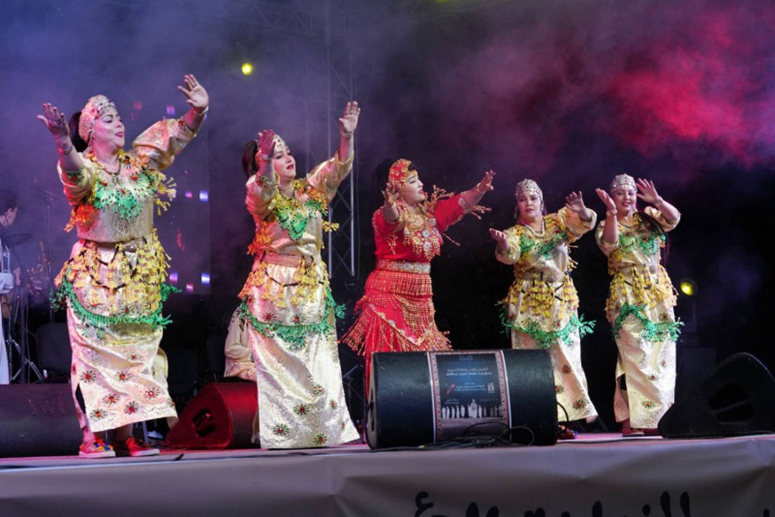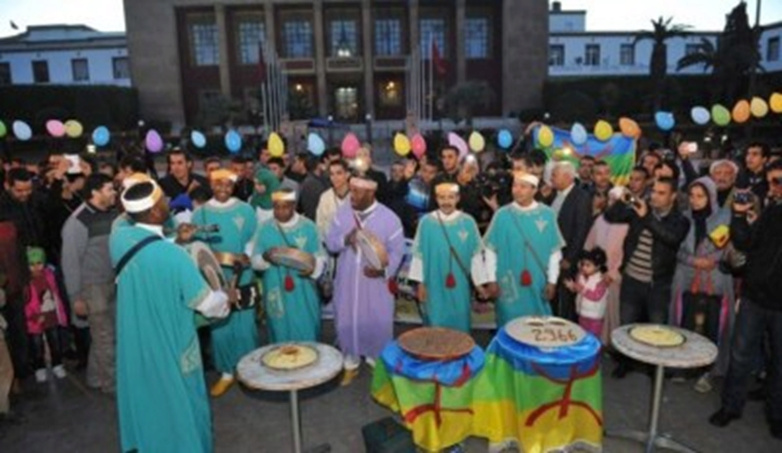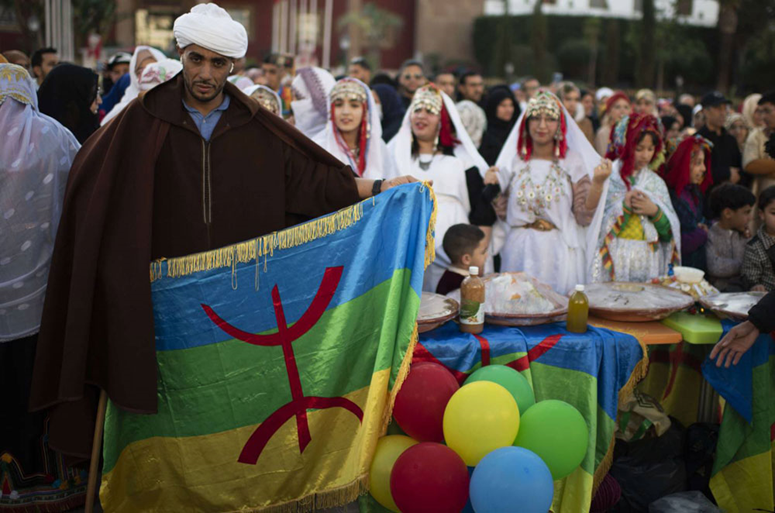The Amazigh New Year is an exceptional Moroccan occasion this year

Morocco celebrates its cultural heritage, the Amazigh, through artistic and cultural events.
Women are the guardians of Moroccan Amazigh heritage
Although the Amazigh are indigenous peoples who inhabit the region extending from the Siwa Oasis in western Egypt in the east to the Atlantic Ocean in the west, and from the Mediterranean Sea in the north to the Sahara Desert in the south, the country most interested in their cultural heritage is Morocco, whose Amazigh component pays special attention, especially in official support, which is What was embodied in the exceptional celebration of the Amazigh New Year in Morocco this year.
Rabat - Moroccan governmental and non-governmental bodies organized a number of celebrations and festivals on the occasion of the Amazigh New Year, which falls on January 13th of each year.
Celebrations began, whether by organizing festivals, school days, or parties that included rituals and traditions passed down through generations. The Amazigh New Year is called “January Night” (January Night).
Official support
Suleiman Sedqi, head of the Moroccan Amazigh Association (non-governmental), said that celebrating the Amazigh New Year is through family visits and preparing specific dishes for the occasion.
In his statement, Sidqi indicated that celebrations are organized in his country and North African countries, pointing out that, for example, in the Souss region (central), the dish “porridge” (wheat flour ground with water) is prepared, as well as “hakouza” (couscous with certain types of vegetables). ) and “Al-Rafisa” (porridge) in other regions of the country.
He continued, “Individuals are keen to wear traditional clothing, considering that the occasion is a cultural and historical heritage.”
He said that this year is characterized by a special character, after the royal decision to adopt January 14th of each year as an official holiday on the occasion of the Amazigh New Year.

Last May, Moroccan King Mohammed VI decided to adopt the Amazigh New Year as an official paid national holiday, similar to the first of Muharram of the Hijri New Year and the Gregorian New Year.
On Friday, Moroccan Prime Minister Aziz Akhannouch in Agadir confirmed that the celebration of the Amazigh New Year, which was approved by King Mohammed VI as an official national holiday, is a celebration of the great heritage of all Moroccans.
Akhannouch said in a statement to the press on the occasion of the celebration of the Amazigh New Year 2974, “Today we celebrate this national occasion in Agadir with the Moroccans, which is a great heritage not only for the Amazigh but for all Moroccans.”
This celebration is considered the first of its kind after this day was approved as an official national holiday. This decision comes, as the Royal Court’s statement confirmed at the beginning of last May, “an embodiment of care for the Amazigh language as a major component of the authentic Moroccan identity, rich in its many tributaries, and a common asset for all Moroccans without exception.” It also falls within the framework of the constitutional enshrinement of Amazigh as the country’s official language alongside the Arabic language.”
This celebration constitutes a prominent manifestation of the efforts made to consolidate the growing interest in Amazigh culture and heritage, and an embodiment of the care that Morocco attaches to this basic component of Moroccan identity. It is also considered one of the manifestations of the keenness to consolidate Amazigh culture in many fields.
This initiative aims to preserve national cultural diversity and consolidate the gains achieved regarding the Amazigh language since the speech delivered by King Mohammed VI in Agadir in 2001.
The celebration of the Amazigh New Year, which falls within the framework of comprehensive development, is symbolic indicative of the deep-rootedness and diversity of the cultural fabric of Moroccans, and indicates the desire to move forward on the path to truly activating the official character of the Amazigh language. It is also a practical answer to the aspirations of Moroccan society in the context of the advancement of the Amazigh language and culture, and the integration of the Amazigh language into education and administration.

The adoption of the Amazigh New Year as an official national holiday has given a strong impetus to the course of measures taken to strengthen national Amazigh action, especially at the cultural levels. It is a step that comes in the context of raising the challenges raised at the level of support for Amazigh culture in Morocco, and strengthening its position in all fields, through implementation. Optimization of the text of the Constitution.
The various steps and events celebrating the adoption of the Amazigh New Year also indicate the government’s involvement in activating workshops on the official character of the Amazigh language.
The executive authority adopts a gradual approach in activating this nature, through the official launch of projects concerned with enhancing the use of the Amazigh language in public administrations and integrating it into various areas of public life.
Several efforts are also being made to provide reception services in the Amazigh language in a group of public administrations, as hundreds of employees have been allocated to receive and guide Amazigh-speaking companions to facilitate their access to public services, and to include the Amazigh language on signs and signposts at the headquarters of public administrations and institutions.
The government confirms that a telephone reception service has also been provided in the Amazigh language in nine call centers affiliated with some ministerial sectors and public institutions, which is witnessing a great demand from stakeholders through the provision of 63 persons responsible for telephone communication in the Amazigh language.
Chapter 5 of the Kingdom’s Constitution stipulates that “Arabic remains the official language of the state.” The state works to protect and develop it, and promote its use. Amazigh is also an official language of the state, as it is a common asset for all Moroccans without exception. An organic law determines the stages of activating the official nature of the Amazigh language, and the methods of integrating it into the field of education, and in priority areas of public life, so that it can perform its function in the future as an official language...”

Art festivals
Many activists on social media platforms shared pictures and video clips of their celebration of the Amazigh New Year this year, including group artistic performances aimed at introducing special festive traditions and rituals.
Several Moroccan cities witnessed the organization of festivals on this occasion, such as the first edition of the National Festival of Amazigh Culture, which was launched under the slogan “Amazigh Culture...Identity and Civilization,” between the twelfth and fourteenth of January in the city of Ourir (north).
The city of Ifrane (north) also hosts several activities, such as holding an exhibition of regional products, performances by Amazigh folk groups, in addition to a henna and clothing ceremony, tasting of local foods, as well as an evening of Amazigh poetry.
One of the most prominent events was the National Festival of Amazigh Culture in the city of Ait Ourir (Al Haouz Province), which was opened by the star of popular and Amazigh music, the artist Mustafa Oumkil, on Saturday evening, and the activities of its first edition continued until Sunday, the fourteenth of January.
Under the applause of the festival goers, who flocked in large numbers to the square of the Mohamed Ben Hamou Ait Said Garden, to meet their favorite star, artist Mustafa Oumkil was able to immerse the audience in the depths of authentic Berber and popular culture, and entertain them with a bouquet of distinguished songs inspired by ancient musical repertoire from the depths of Morocco.
The artist gave a distinguished performance that celebrated popular and Amazigh culture, which is considered one of the basic components of the multiple and unified Moroccan identity. He was able to skillfully combine Amazigh and popular songs, so the concert was an occasion to highlight once again that music remains a true global language.

The festival's audience was also treated to a rich programming through the presentation of distinguished performances in which songs were mixed with dance and music by a group of musical bands such as “Ahwash Akajkal” and “Shabab Mashtoun.”
The audience, residents and visitors of the city of Ait Ourir, also enjoyed rhythms and musical performances performed by the “Ahouach Tapia” group, the “Tamaket” group, and the “Ait Tamaten El Haouz” group.
In a statement, the head of the Cultural Affairs Department of the Regional Directorate of Culture for the Marrakesh-Safi region, Samir Ounassi, highlighted the importance of this festival dedicated to Amazigh culture, recalling the special attention that Morocco pays to Amazigh culture as a national heritage that should be celebrated and cared for as a component of Moroccan culture and civilization.
He added, “Given the great demand for this demonstration, the Ministry of Culture sees the localization of this festival in the city of Aït Ourir, in line with the Ministry’s strategy aimed at organizing local festivals in the Marrakesh-Safi region,” announcing in this regard the organization of a festival dedicated to youth music on the 19th. January 20th in Chichaoua.
For his part, the artist Oumkil expressed his happiness at being in the city of Ait Ourir to participate in the National Festival of Amazigh Culture, highlighting the distinguished organization of this demonstration.
He also expressed hope that this festival would continue to become a distinguished annual event to celebrate Amazigh culture in its richness and uniqueness.
This festival is organized by the Ministry of Youth, Culture and Communication - Culture Sector over a period of three days under the slogan “Amazigh culture... identity and civilisation”, in implementation of the ministry’s strategy in the axis of supporting creativity and keeping pace with creators, and within the framework of pride in the Moroccan identity with its diverse cultural and civilizational tributaries and components. In order to highlight the cultural, heritage and civilizational qualifications of the region in general, and the Al Haouz province in particular.

Through this young cultural festival, which is considered one of the mechanisms for preserving the cultural heritage, introducing it and valuing it to be an important lever for sustainable development in the region, the Ministry seeks to contribute to laying the foundations for an effective and productive cultural act that contributes to preserving the national heritage and anticipating promising future prospects based on foundations. Cultural right and comprehensive local development.
The festival aims to preserve and value the Amazigh heritage so that it contributes to the integrated economic, social and regional development system, stimulate national and regional cultural tourism, connect people with their rich cultural heritage, revive the historical memory of Moroccans in a way that strengthens belonging to the homeland, as well as highlight the power of intellectual radiation and the material and intangible creativity of Amazigh culture, and interest. Researching and documenting the components of the Amazigh artistic heritage, and taking care of young talents and energies in the field of Amazigh song.
The activities of this session, held in cooperation with the prefecture of the Al Haouz Province, the Regional Council and the Aït Ourir Collective Council, witnessed the participation of about 19 heritage groups representing the various traditional artistic colors and the Amazigh visual arts locally and nationally, in addition to artistic evenings performed by a group of Amazigh song stars.
In parallel with the activities of the artistic evenings, a scientific symposium was programmed that sheds light on the cultural specificity of Amazigh culture and the prospects for investing its potential in sustainable development in the city of Aït Ourir, with the participation of a group of specialized professors, as well as an exhibition of fine arts and another on traditional dress, in addition to a third exhibition on Amazigh books aimed at Introducing the most important Amazigh-language publications and the most important achievements in this field.
Historical roots

In this regard, researchers in Amazigh culture confirmed Friday in Rabat that celebrating the Amazigh New Year, especially after its beginning was declared an official holiday, is a consecration of Morocco’s cultural and civilizational diversity.
These researchers highlighted, in their statements on the sidelines of a study day organized by the Royal Institute of Amazigh Culture on the topic “The Amazigh Year (Eyed Inyir): Historical Roots and Celebratory Practices,” that this celebration once again highlights the multiculturalism that characterizes Morocco.
In this context, the Director of the Center for Didactic Research and Pedagogical Programs at the Institute, Abdel Salam Khalfi, said that the celebration of “Eid Inahir” has a prominent historical aspect, as it goes back many centuries in Morocco, as well as because it is linked to the close and special relationship that has always linked the Amazigh person to the land and the agricultural field in general.
For his part, the researcher at the Center for Historical and Environmental Studies, also affiliated with the institute, Hussein Boudlib, stopped at the celebration of the Moroccan community residing abroad for the Amazigh New Year, highlighting that Moroccans around the world contribute effectively to introducing Amazigh culture and marketing it at the level of the countries in which they live, “particularly It carries rich and multiple human values, linked to solidarity and equality.”
For her part, the researcher at the same center, Sabah Allache, highlighted that Moroccan women “are considered the backbone of the celebration of the Amazigh Agricultural Year (Eyed Inair), through a set of rituals and customs that they perform, such as preparing a set of traditional Moroccan dishes.”
She pointed out that these rituals and customs represent a valuable identity heritage that Amazigh women inherited from ancient generations, and they are keen to preserve and protect it, in order to transmit it in all its details to future generations.

It should be noted that the program of this study day was divided into two scientific sessions, the first of which dealt with the topics of “The Historical Roots of the Amazigh Calendar,” “An Introduction to the Study of the Amazigh Calendar,” and “The Contribution of the Royal Institute of Amazigh Culture to Modernizing and Institutionalizing the Celebration of the Amazigh New Year.” And “the making of cultural symbols and their importance in preserving identity.”
While the second session focused on “the connotations and rituals of the Amazigh Year,” “the presence of women in celebrating the Amazigh Year,” “the rituals of celebrating January in the Zemmour region,” “some aspects of celebrating the Amazigh Year in the oases of southern Morocco,” and “Moroccans of the World.” And celebrating the Amazigh New Year.”
Source: sites Internet

